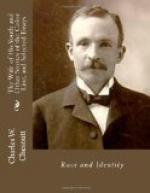At school Sophy and Prince vied with each other in their attentions to Miss Myrover. But when school was over, Prince went away with her, and Sophy stayed behind; for Miss Myrover was white and Sophy was black, which they both understood perfectly well. Miss Myrover taught the colored children, but she could not be seen with them in public. If they occasionally met her on the street, they did not expect her to speak to them, unless she happened to be alone and no other white person was in sight. If any of the children felt slighted, she was not aware of it, for she intended no slight; she had not been brought up to speak to negroes on the street, and she could not act differently from other people. And though she was a woman of sentiment and capable of deep feeling, her training had been such that she hardly expected to find in those of darker hue than herself the same susceptibility—varying in degree, perhaps, but yet the same in kind—that gave to her own life the alternations of feeling that made it most worth living.
Once Miss Myrover wished to carry home a parcel of books. She had the bundle in her hand when Sophy came up.
“Lemme tote yo’ bundle fer yer, Miss Ma’y?” she asked eagerly. “I ’m gwine yo’ way.”
“Thank you, Sophy,” was the reply. “I ’ll be glad if you will.”
Sophy followed the teacher at a respectful distance. When they reached Miss Myrover’s home, Sophy carried the bundle to the doorstep, where Miss Myrover took it and thanked her.
Mrs. Myrover came out on the piazza as Sophy was moving away. She said, in the child’s hearing, and perhaps with the intention that she should hear: “Mary, I wish you would n’t let those little darkeys follow you to the house. I don’t want them in the yard. I should think you ’d have enough of them all day.”
“Very well, mother,” replied her daughter. “I won’t bring any more of them. The child was only doing me a favor.”
Mrs. Myrover was an invalid, and opposition or irritation of any kind brought on nervous paroxysms that made her miserable, and made life a burden to the rest of the household, so that Mary seldom crossed her whims. She did not bring Sophy to the house again, nor did Sophy again offer her services as porter.
One day in spring Sophy brought her teacher a bouquet of yellow roses.
“Dey come off’n my own bush, Miss Ma’y,” she said proudly, “an’ I didn’ let nobody e’se pull ’em, but saved ’em all fer you, ’cause I know you likes roses so much. I ’m gwine bring ’em all ter you as long as dey las’.”
“Thank you, Sophy,” said the teacher; “you are a very good girl.”
For another year Mary Myrover taught the colored school, and did excellent service. The children made rapid progress under her tuition, and learned to love her well; for they saw and appreciated, as well as children could, her fidelity to a trust that she might have slighted, as some others did, without much fear of criticism. Toward the end of her second year she sickened, and after a brief illness died.




